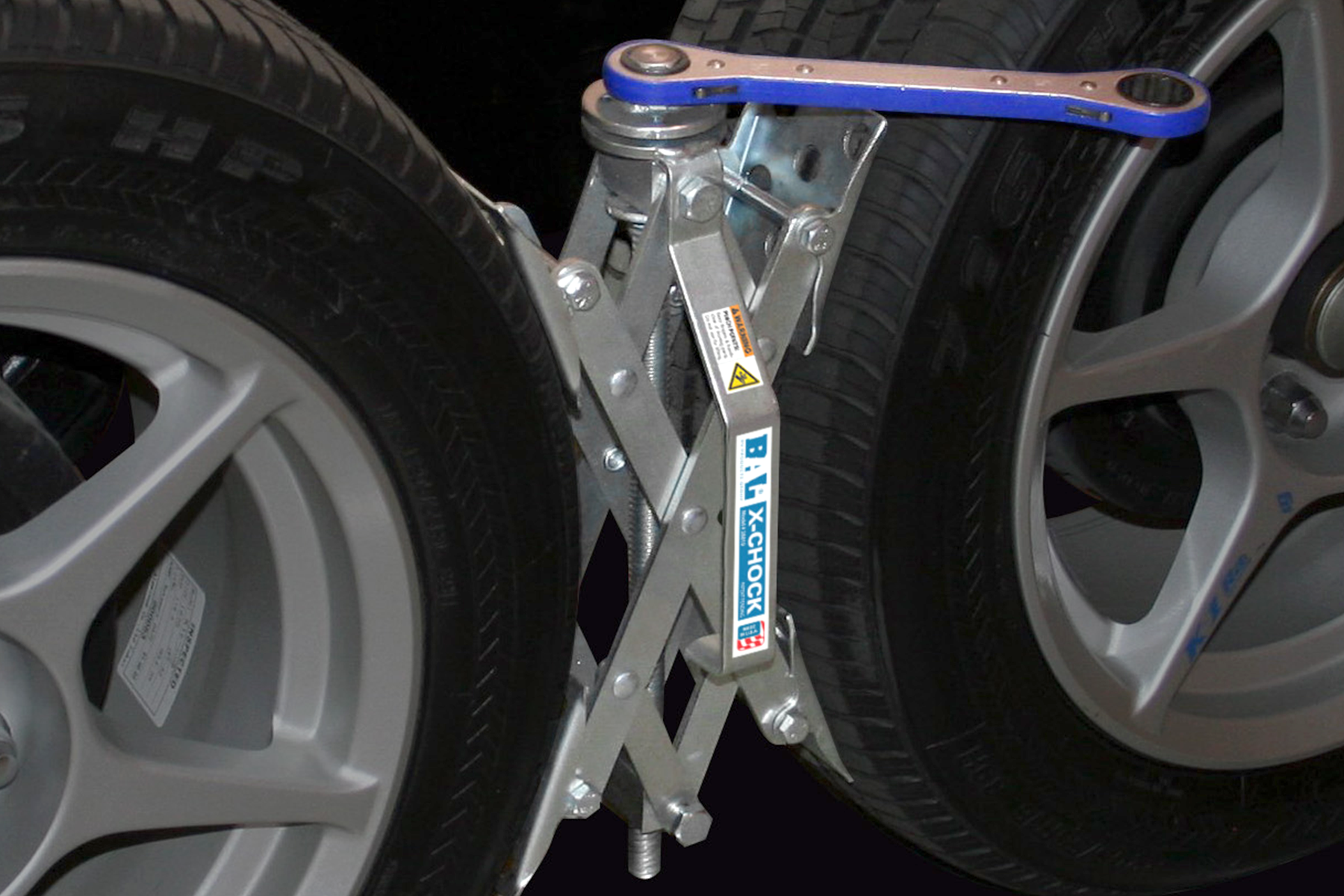WHY USE CHOCKS?
Wheel chocks are an important part of achieving the stability you desire in your tent trailer, travel trailer, or fifth wheel trailer.
Unlike motor homes, trailers do not have a built-in parking brake. Therefore, trailers have no mechanism to control front to rear rocking movement. Stabilizing jacks, when extended, help put a damper on this movement, but most people prefer to eliminate it altogether. This is where wheel chocks come in to play.
WHY USE BAL DESIGNED AND PATENTED TRAILER CHOCKS?
To virtually eliminate the front to rear rocking movement in trailers of all kinds, BAL has designed and patented a line of wheels chocks to fit every trailer’s needs.
Tent trailer owners should use the single-tire locking chock. One chock (model #: 28020), secured around one tire on your trailer, used in combination with BAL’s tent trailer tire leveler (model #: 28050), used on your low side tire, will give you a sense of stability never before achievable. You should use a wrench to apply extra pressure against your tire after securing the wedges against your tire by hand. Make sure your stabilizers are BAL tent trailer jacks (model #’s: 23005, 23007, 23025, or 23026) or this stability won’t be achieved.
Travel trailers and fifth wheel trailers should use either of BAL’s dual or triple axle locking chocks. Model number 28000 sits on the ground between the tires, and will fit between most tandem trailer tires. Two metal wedges are extended by a screw mechanism, which applies opposing forces on the tires. A hand-operated wingnut is used to quickly extend or retract the metal wedges. A wrench may be used to apply extra force for added stability, or to retract the wedges for removal.
BAL’s deluxe tire locking chock (model #: 28005) goes between the tires, but requires at least 2 ½” of clearance between the tires to fit. It is a mini scissors jack, that when activated with a ratchet wrench (supplied), applies opposing forces on the tires. Model number 28005 can apply more force against the tires than model number 28000. Also, a piece of wood placed under BAL model 28000 may produce better results when used on soft surfaces like grass, gravel, or dirt. One chock will eliminate most of your front to rear movement, and two chocks will add even more stability.
NOTE: BAL’s chocks are designed for locking trailer tires when camping. They should be put in place after disconnecting from your tow vehicle and after putting down your stabilizing jacks. They should be removed prior to hooking up to your tow vehicle. Failure to do so may damage your chocks. To avoid undesired trailer movement when disconnecting or hooking up to your tow vehicle, a tire “wedge” should be firmly placed behind one, or preferably both rear trailer tires.
WHY USE CHOCKS?
Wheel chocks are an important part of achieving the stability you desire in your tent trailer, travel trailer, or fifth wheel trailer.
Unlike motor homes, trailers do not have a built-in parking brake. Therefore, trailers have no mechanism to control front to rear rocking movement. Stabilizing jacks, when extended, help put a damper on this movement, but most people prefer to eliminate it altogether. This is where wheel chocks come in to play.
WHY USE BAL DESIGNED AND PATENTED TRAILER CHOCKS?
To virtually eliminate the front to rear rocking movement in trailers of all kinds, BAL has designed and patented a line of wheels chocks to fit every trailer’s needs.
Tent trailer owners should use the single-tire locking chock. One chock (model #: 28020), secured around one tire on your trailer, used in combination with BAL’s tent trailer tire leveler (model #: 28050), used on your low side tire, will give you a sense of stability never before achievable. You should use a wrench to apply extra pressure against your tire after securing the wedges against your tire by hand. Make sure your stabilizers are BAL tent trailer jacks (model #’s: 23005, 23007, 23025, or 23026) or this stability won’t be achieved.
Travel trailers and fifth wheel trailers should use either of BAL’s dual or triple axle locking chocks. Model number 28000 sits on the ground between the tires, and will fit between most tandem trailer tires. Two metal wedges are extended by a screw mechanism, which applies opposing forces on the tires. A hand-operated wingnut is used to quickly extend or retract the metal wedges. A wrench may be used to apply extra force for added stability, or to retract the wedges for removal.
BAL’s deluxe tire locking chock (model #: 28005) goes between the tires, but requires at least 2 ½” of clearance between the tires to fit. It is a mini scissors jack, that when activated with a ratchet wrench (supplied), applies opposing forces on the tires. Model number 28005 can apply more force against the tires than model number 28000. Also, a piece of wood placed under BAL model 28000 may produce better results when used on soft surfaces like grass, gravel, or dirt. One chock will eliminate most of your front to rear movement, and two chocks will add even more stability.
NOTE: BAL’s chocks are designed for locking trailer tires when camping. They should be put in place after disconnecting from your tow vehicle and after putting down your stabilizing jacks. They should be removed prior to hooking up to your tow vehicle. Failure to do so may damage your chocks. To avoid undesired trailer movement when disconnecting or hooking up to your tow vehicle, a tire “wedge” should be firmly placed behind one, or preferably both rear trailer tires.

